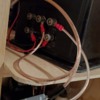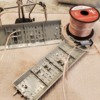I took the time today to change one of my fastrack loops from the DC power pack to being powered by one of my postwar transformers, an RW. When I was all done it didn't work. I discovered that I mistakenly purchase CCA wire vs pure copper. What I'm trying to figure out is if the problem I'm having is from the wire or something else I've done.
I took the hot wire from the transformer through a 5 Amp breaker (I have a TVS across the binding posts on the transformer), then I run the 16 gauge wire to a distribution block on the layout and have two feeder wires to the loop, about an 6 foot loop of track.
I'm getting the right reading on my multimeter on the transformer posts, 15 Volts, but when I go the distribution block or the track I'm only getting about 6 volts. The run from the transformer to the distribution block is about 9 feet, then about 2 feet from their to the track.
I put an MPC conventional engine I have on the track and I couldn't get it to even light up, let alone run.
Based on that description, does it sound like the CCA wire is the cause for my voltage drop off from the transformer to the track or is it something else? I attached some pictures for reference as well.









